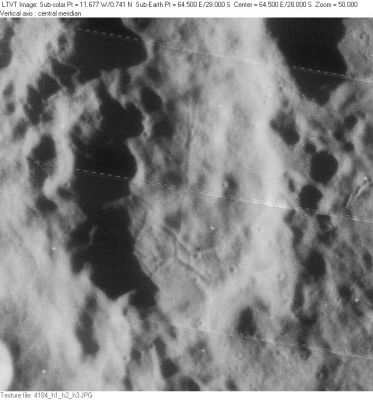Palitzsch
Contents
Palitzsch
|
Lat: 28.03°S, Long: 64.37°E, Diam: 41.87 km, Depth: 2.87 km, [/R%C3%BCkl%2059 Rükl 59] |
Table of Contents

LOIV-184-H2 Palitzsch is at the south end of the elongated trench known as [/Vallis%20Palitzsch Vallis Palitzsch]. The boundary between the two does not seem to be clearly defined in the [/IAU%20nomenclature IAU nomenclature].
Images
LPOD Photo Gallery Lunar Orbiter Images Apollo Images
The location of the Concentric Crater near Legendre (which was included as item N°10 in C.A.Wood's list of 1978), should be immediately south of Palitzsch B (east of Palitzsch itself and northwest of Legendre). I have tried to detect this Concentric Crater on the Hi-Res scan of Lunar Orbiter 4's photograph LOIV-184-h2, alas... Perhaps there are much more detailed orbital photographs to discover (or to re-discover) the exact location of C.A.Wood's Concentric Crater "N°10".
Research: Danny Caes
Maps
([/LAC%20zone LAC zone] 98C4) LAC map Geologic map
Description
Elger
([/IAU%20Directions IAU Directions]) PALITZSCH.--If this extraordinary formation is observed when the moon is about three days old, it resembles a great trough, or deep elongated gorge flanking the E. wall of [/Petavius Petavius], though it is a true ring-plain, albeit of a very abnormal type, about 60 miles in length and 20 miles in breadth, with a somewhat dusky interior. On the outer slope of its E. wall is a bright ring-plain with a lofty border and a central mountain.
Wikipedia
Additional Information
- IAU page: Palitzsch
- Depth data from [/Kurt%20Fisher%20crater%20depths Kurt Fisher database]
- Westfall, 2000: 2.87 km
- Satellite crater Palitzsch B is on the [/ALPO%20list%20of%20bright%20ray%20craters ALPO list of bright ray craters] and is mapped by the USGS as Copernican in age.
- Palitzsch B central peak height:
- [/Sekiguchi%2C%201972 Sekiguchi, 1972]: 1.5 km - fatastronomer fatastronomer
- Concentric Crater south of Palitzsch B (?).
Nomenclature
- Named for Johann Georg Palitzsch (June 11, 1723 – February 21, 1788), a German astronomer. In December 1758 he observed the return of Comet Halley, as had been predicted by Edmond Halley in 1705.
- According to [/Whitaker Whitaker] (p. 218), this name was introduced by [/Schr%C3%B6ter Schröter], who spelled it Palitsch.
LROC Articles
LPOD Articles
Bibliography
[/Alphabetical%20Index Named Features] -- Prev: [/Palisa Palisa] -- Next: [/Vallis%20Palitzsch Vallis Palitzsch]
This page has been edited 1 times. The last modification was made by - tychocrater tychocrater on Jun 13, 2009 3:24 pm - afx3u3